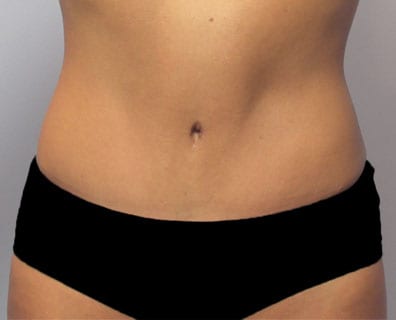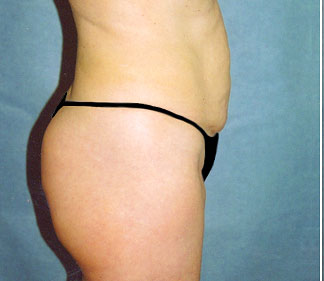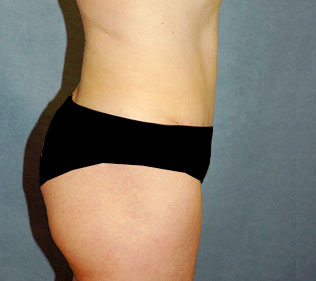choosing the Belvedere for your tummy tuck
Abdominoplasty or ‘a tummy tuck’ as it’s more commonly known is one of the most commonly asked for procedures following substantial weight loss or pregnancy, where abdominal muscles are weaker and the skin has become loose.
Sometimes exercise and diet alone is not enough to reverse this and can cause anxiety and self-consciousness. With a tummy tuck, skin can be removed and muscles tightened to leave a flatter and firmer tummy. Many customers will combine their tummy tuck with liposuction to give a slimmer waistline and overall slimmer body profile.
The tummy tuck procedure has been carried out at the Belvedere Clinic for over 25 years, with hundreds of men and women leaving our hospital much happier and free from anxiety – and of course a much firmer, flatter tummy.
Did you know....?
there are medical benefits to having a tummy tuck
Tummy tucks have some less well known medical benefits, making them a great option for most people.
Medical benefits of a tummy tuckTypes of Abdominoplasty (tummy tuck)
Complete Abdominoplasty (Full Tummy Tuck)
A complete (or full) abdominoplasty generally follows these steps:
- An incision is made from hip to hip just above the pubic area.
- Another incision is made to free the navel from the surrounding skin.
- The skin is detached from the abdominal wall to reveal the muscles and fascia to be tightened. The muscle fascia wall is tightened with sutures.
- Liposuction is often used to refine the transition zones of the abdominal sculpture.
- A dressing and sometimes a compression garment are applied and any excess fluid from the site is drained.
Partial Abdominoplasty (Mini Tummy Tuck)
A partial (or mini) abdominoplasty generally proceeds as follows:
- A smaller incision is made.
- The skin and fat of the lower abdomen are detached in a more limited fashion from the muscle fascia. The skin is stretched down and excess skin removed.
- Sometimes the belly button stalk is divided from the muscle below and the belly button slid down lower on the abdominal wall.
- Sometimes a portion of the abdominal muscle fascia wall is tightened.
- Liposuction is often used to contour the transition zone.
- The flap is stitched back into place.

Finance Options
If you thought you couldn't afford plastic surgery, think again. Find out whether we can provide you with finance for your procedure. Meet a few key criteria and you could be eligible for a loan.
Click for Finance


Complementary Procedures To Tummy Tuck Surgery
Liposuction is very often carried out at the same time as abdominoplasty as it can really enhance the final outcome. A number of our patients will combine their tummy tuck with liposuction to give a slimmer waistline.
Usually performed under general anaesthetic, the loose skin and fatty tissue are removed through an incision across the abdomen and the damaged abdominal muscles are repaired and tightened.
Procedure Time: 3 hours
No of Procedures Needed: 1
Recovery Time: 10-12 weeks
Take a look at Kerry Katona’s journey where she coupled a tummy tuck with liposuction for some amazing results. Kerry also completed a short film to enable others to see how the Belvedere Clinic helped her to realise the shape she really wanted.

Ready to discuss your tummy tuck surgery?
Get in touch with our friendly and helpful team now, for a no-obligation chat about your transformation.
Contact the Belvedere ClinicTummy Tuck Before and After Photos




Recovery
You should not engage in driving or heavy work for at least 2 weeks following your abdominoplasty procedure and should limit mobility altogether for the first week. Dressing and pressure garment must be kept in place for 4 weeks and you should shower (not bath) until skin is healed. After your first wound check up you should continue to wear the pressure garment for a further 6 weeks. You will be able to start routine work after 4 weeks but this should be gradual and subject to how well the wound is healing. Your surgeon will discuss this in detail with you however if you have any queries feel free to call us on the number below.
Watch our patient story video about the tummy tuck procedure

Abdominoplasty FAQs
If you are considering Abdominoplasty (a tummy tuck), you are likely to have some questions.
These FAQ will help to answer some of the most common questions for those seeking a tummy tuck in the UK.
Abdominoplasty is a surgical procedure to take away extra skin and fat. The aim is to create a flatter tummy, often following pregnancy or gaining and losing weight. It can also help to re-join the muscles of the abdominal wall if they have been pulled apart in the middle (known as ‘diversification of the recti’).
Stretch marks can sometimes be cut away or tightened to make them less obvious. Ideally, your weight will be within a 'normal' range before the surgery.
A tummy tuck is not for people who are overweight, or wish to use the procedure as a method to lose weight. For the right person, a tummy tuck can make a big difference to their confidence and quality of life.
You will meet your surgeon to talk about why you want surgery and what you want to achieve. The surgeon will make a note of any medical history you currently have or have had in the past. They will also make a record of any medication you are on, including herbal remedies and medicines that are not prescribed by your doctor.
Your surgeon will examine your tummy, and may take some photographs for your medical records. They will ask you if you want to have someone with you during the examination, and ask you to sign a consent form for taking, storing and using the photographs.
The nurse will measure your height and weight at pre assessment to make sure that it is safe to perform your surgery. If you are overweight, pregnant or planning to become pregnant, your surgeon may suggest delaying your operation.
With a mini tummy tuck, a smaller amount of skin and fat is removed from the lower tummy, though there will still be a long horizontal scar above the pubic hair. Sometimes the muscles will also be tightened. No scar is left around the tummy button, which may be stretched to become a different shape. A mini tummy tuck will give less of an effect than a full tummy tuck.
The fleur-de-lis
For patients with lots of extra skin on the lower and upper tummy, a fleur-de-lis tummy tuck might be appropriate. Here, as well as the long horizontal cut of the standard tummy tuck, there is a vertical cut too, so the scar looks like an anchor.
Generally, when a patient undergoes a tummy tuck, under general anaesthetic, an incision is made above the pubic area from one hip to the other hip.
An additional incision is made to release the navel from the surrounding skin, which is then released from the abdominal wall, revealing the fascia and muscles that are to be tightened with sutures. Sometimes, liposuction is combined with a tummy tuck for further tightening. A patient may receive a dressing and compression garment to drain any excess fluid.
A conventional tummy tuck typically takes three hours, and only one procedure is needed.
Tummy tucks are usually carried out under a general anaesthetic (so you would be asleep). The operation usually takes about three hours, and you would usually spend one day in hospital.
When you wake up from your operation you may have a drip to give you fluid while you are not drinking. You might be given antibiotics to keep the wound clean. You may also have drainage tubes in your lower tummy to drain away any fluid or blood. These tubes will be taken out when the fluid or blood has stopped draining, usually before you go home. Your tummy will feel tight and sore. Simple painkillers should be enough to keep you comfortable.
You will have some dressings on your tummy. You may need to wear a well-fitting support garment, usually for weeks after the operation. You will be asked to keep your knees and hips bent whenever possible to take the strain off your stitches.
You will be out of bed on the same day as your surgery, and doing light activities after two weeks. You should be back to normal exercise in six weeks. While you are in hospital, you will be given blood-thinning injections and support stockings, to reduce the risk of a clot in the leg (DVT) or the lung (PE).
You will need to avoid strenuous activity for 10 to 12 weeks. Most patients take up to four weeks off work after the operation, depending on their job. Your tummy will be sore and swollen for weeks to months after the operation. Do not lift heavy things for several weeks, and avoid sex for at least three weeks. You should start gently, with all activities. Do not drive until you feel safe and are comfortable wearing a seatbelt. Check your insurance documents if you are not sure.
At first your tummy skin may seem too tight. This usually settles down within six weeks of the surgery. Most patients are pleased with the final result, but some find their new shape difficult to get used to. This may happen to you. You may have more or less sensation in the skin on your tummy, and this can change over time.
Abdominoplasty procedure is not intended for people who are severely overweight that want to lose weight. There are other procedures that are more appropriate for serious weight loss.
Ethical cosmetic surgeons will not perform a tummy tuck on anyone under the age of 18. With regards to being too old, your doctor will be more interested in health, fitness and lifestyle and will always make a personal assessment on your suitability for surgery.
The results of your tummy tuck surgery will last for many years, but it is up to you to maintain a healthy weight. Furthermore, as a person ages, the skin loses elasticity. Weight gain, as well as a loss of elasticity, can impact the results of a tummy tuck, so you will need to maintain a healthy lifestyle to maintain the results achieved for as long as possible.
Complications with a tummy tuck are rare. However, there can be bleeding and infection, which is a risk with any surgery. There can also be fluid collection, poor scarring and an asymmetrical appearance. To reduce the possibility of complications, it’s important to follow your doctor’s instructions fully. Discuss each of them with your plastic surgeon to make sure you understand the potential complications and consequences.
Although many patients combine liposuction with their tummy tuck surgery, additional surgery, such as breast augmentation, is in an entirely different area and therefore, is subject to the condition of your health and the go-ahead from a doctor. Discuss this with your plastic surgeon to make sure you understand the potential complications and consequences.
If you are a woman who plans to get pregnant or have a series of pregnancies, it is recommended that you wait until after your pregnancies to have a tummy tuck.
Pre & Post Plastic Surgery Care
Find out how to prepare for your surgery and how to take care of yourself afterwards, for a fast and safe recovery.
Pre and post surgery careFind Your Cosmetic Surgeon
Find out more about our plastic surgeons and what makes them the best and most experienced team to carry out your procedure.
Meet the TeamTummy Tuck following a Caesarean Section
More women than ever before are now taking back control of their bodies following pregnancy and a caesarean section. Women are choosing to regain their pre-pregnancy tummy with the help of a tummy tuck (abdominoplasty). Below we explore what a tummy tuck actually is, how it can benefit women post caesarean section, and a few common questions about this cosmetic procedure.
When you have a caesarean section the surgeon will need to cut through your stomach muscles and tissue to access the womb. As a result, scar tissue can form and the skin can sag. Exercise will not help this excess skin to become firm.

You may also be interested in these procedures



